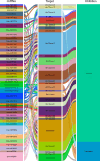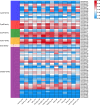Identification and expression analysis of the cysteine synthase (CSase) gene family in Brassica napus L. under abiotic stress
- PMID: 40474087
- PMCID: PMC12139137
- DOI: 10.1186/s12870-025-06532-8
Identification and expression analysis of the cysteine synthase (CSase) gene family in Brassica napus L. under abiotic stress
Abstract
Cysteine is the first organic compound identified in plants that contains both sulfur and nitrogen. It serves as a precursor for sulfur-containing metabolites such as methionine, glutathione (GSH), and Fe-S clusters, all of which play crucial roles in plant growth, development, and stress responses. Cysteine synthase (CSase) catalyzes the final step in cysteine biosynthesis; therefore, studying the CSase gene family is essential for understanding its role in plant abiotic stress tolerance. Using the CSase protein sequences of Arabidopsis thaliana as seed sequences and integrating protein domain information, 69 members of the BnCSase gene family were identified from the whole genome of Brassica napus ZS11. These members were analyzed for their physicochemical properties, phylogenetic relationships, covariance relationships, protein-protein interaction (PPI) networks, associated miRNAs, and SNP variations. Based on transcriptome data, the expression patterns of BnCSase genes under different abiotic stress treatments were investigated. Furthermore, the relative expression levels of several BnCSase genes were analyzed under salt, alkali, low nitrogen, and drought stress treatments at 0, 6, 12, and 24 h using qRT-PCR to explore their roles in abiotic stress tolerance in B. napus. The results revealed distinct expression patterns of BnCSase genes in response to different abiotic stress signals, indicating stress-specific responses in B. napus. This study provides a theoretical basis for elucidating the functions and molecular genetic mechanisms of the BnCSase gene family in abiotic stress tolerance in rapeseed.
Keywords: Brassica napus L.; Abiotic stress; Cysteine synthase; Gene family.
© 2025. The Author(s).
Conflict of interest statement
Declarations. Ethics approval and consent to participate: Study complied with local and national regulations for using plants. Consent for publication: Not applicable. Competing interests: The authors declare no competing interests.
Figures














Similar articles
-
Identification and expression analysis of the Xyloglucan transglycosylase/hydrolase (XTH) gene family under abiotic stress in oilseed (Brassica napus L.).BMC Plant Biol. 2024 May 15;24(1):400. doi: 10.1186/s12870-024-05121-5. BMC Plant Biol. 2024. PMID: 38745278 Free PMC article.
-
Genome-wide identification of SIMILAR to RCD ONE (SRO) gene family in rapeseed (Brassica napus L.) reveals their role in drought stress response.Plant Signal Behav. 2024 Dec 31;19(1):2379128. doi: 10.1080/15592324.2024.2379128. Epub 2024 Jul 14. Plant Signal Behav. 2024. PMID: 39003725 Free PMC article.
-
Genome-wide investigation of HD-ZIP gene family and functional characterization of BnaHDZ149 and BnaHDZ22 in salt and drought response in Brassica napus L.Plant Sci. 2024 Sep;346:112130. doi: 10.1016/j.plantsci.2024.112130. Epub 2024 May 23. Plant Sci. 2024. PMID: 38795751
-
Molecular and biochemical analysis of serine acetyltransferase and cysteine synthase towards sulfur metabolic engineering in plants.Amino Acids. 2002;22(3):231-43. doi: 10.1007/s007260200011. Amino Acids. 2002. PMID: 12083067 Review.
-
A quick guide to the calcium-dependent protein kinase family in Brassica napus.Genome. 2025 Jan 1;68:1-12. doi: 10.1139/gen-2024-0053. Epub 2024 Nov 5. Genome. 2025. PMID: 39499907 Review.
References
-
- Birke H, Haas FH, De Kok LJ, Balk J, Wirtz M, Hell R. Cysteine biosynthesis, in concert with a novel mechanism, contributes to sulfide detoxification in mitochondria of Arabidopsis thaliana. Biochem J. 2012;445:275–83. 10.1042/bj20120038. - PubMed
-
- Khare R, Kumar S, Shukla T, Ranjan A, Trivedi PK. Differential sulphur assimilation mechanism regulates response of Arabidopsis thaliana natural variation towards arsenic stress under limiting sulphur condition. J Hazard Mater. 2017;337:198–207. 10.1016/j.jhazmat.2017.05.009. - PubMed
-
- Takahashi H, Kopriva S, Giordano M, Saito K, Hell R. Sulfur assimilation in photosynthetic organisms: molecular functions and regulations of transporters and assimilatory enzymes. Annu Rev Plant Biol. 2011;62:157–84. 10.1146/annurev-arplant-042110-103921. - PubMed
-
- Droux M. Sulfur assimilation and the role of sulfur in plant metabolism: a survey. Photosynth Res. 2004;79:331–48. 10.1023/B:PRES.0000017196.95499.11. - PubMed
MeSH terms
Substances
Grants and funding
- U22A20469/the Natural Science Foundation of China
- U22A20469/the Natural Science Foundation of China
- 2022ZD04010/Biological Breeding Special
- 2016YFD0100202-25/The National Key Research and Development Program
- 06270015/The Project for Building the Unique Biological and Natural Resources Database of the Hanjiang River Basin Hubei Province
LinkOut - more resources
Full Text Sources
Miscellaneous

